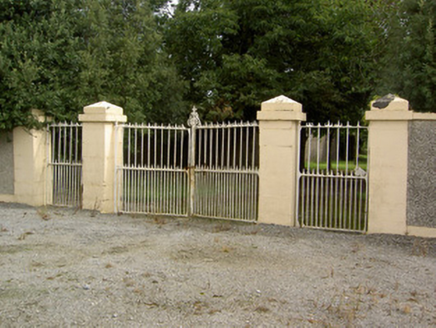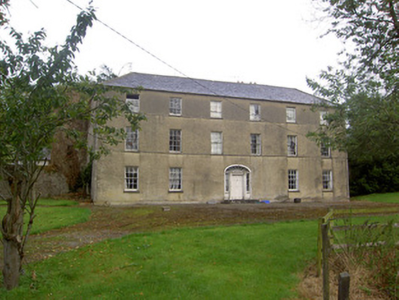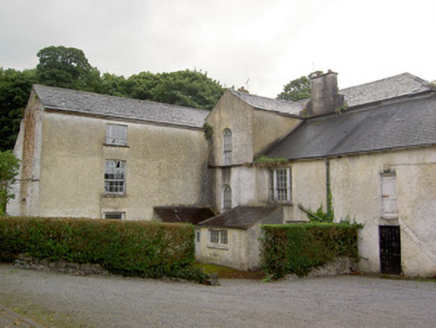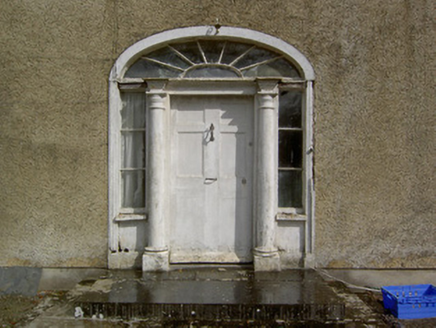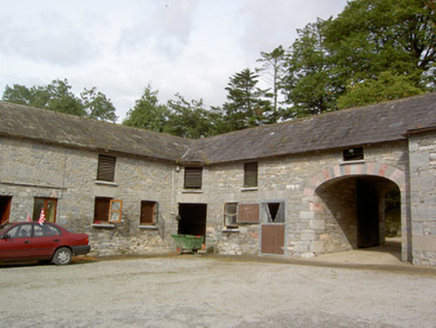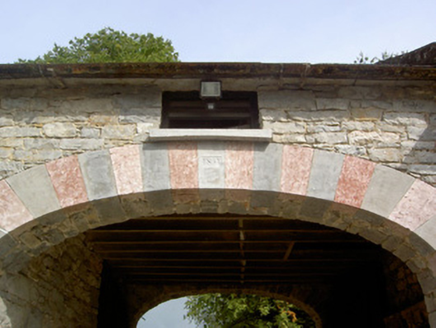Survey Data
Reg No
20807008
Rating
Regional
Categories of Special Interest
Archaeological, Architectural, Historical
Original Use
Country house
Date
1720 - 1820
Coordinates
150221, 113723
Date Recorded
28/08/2006
Date Updated
--/--/--
Description
Detached six-bay three-storey country house, built c. 1800, with slightly lower three-storey stairs return to rear, flanked by two-storey block at west end of rear, parallel to axis of main block, and similar height three-storey block at right angles to east end of rear. Single-and two-bay single- and two-storey extensions to latter blocks and to north-east corner of main block. Slate roofs throughout, hipped to main block, pitched to three-storey rear block, lean-to to two-storey block and to extensions, with cast-iron rainwater goods and rendered chimneystacks. Roughcast rendered walls, front elevation having render plinth and edging and smooth rendered string courses at upper floor sill levels. Square-headed window openings with limestone sills, having six-over-three pane timber sliding sash windows to top floor and six-over-six pane to lower floors. Round-headed openings to stairs return, with six-over-six pane timber sliding sash windows. West rear block has tripartite nine-over-six pane timber sliding sash windows. East rear block has eight-over-four pane window to top floor and twelve-over-eight pane to first floor. Elliptical-headed door opening comprising timber panelled door flanked by timber engaged columns and paned sidelights, and surmounted by spoked fanlight, approached by cut limestone steps. L-plan outbuilding to north-west, having re-entrant corner and integral carriageway through eastern range. Pitched slate roofs with cast-iron rainwater goods, with ashlar limestone bellcote to northern range. Random rubble limestone walls with tooled limestone quoins, and tooled limestone voussoirs to openings. Elliptical-arched opening to north block having alternating tooled limestone and possibly Churchtown marble voussoirs, with date inscribed on keystone. Cut tooled limestone gate piers to south entrance of yard. Random rubble limestone walled garden to west of site, having elliptical-headed entrance with tooled cut limestone voussoirs to east wall. Painted stone piers with decorative wrought-iron double-leaf and pedestrian gates set in pebbledash walls with painted cut-stone coping to south-west of site.
Appraisal
An imposing Georgian country house whose exterior form and character has changed little since the late eighteenth century. The house retains all of its timber sliding sash windows, including some round-headed and tripartite arrangements to the rear, along with an attractive neo-Classical doorcase unusually occupying the position both between and in place of the third and fourth bays of the ground floor. The outbuildings exhibit fine stone workmanship, most notably in the bellcote and the limestone and possibly Churchtown marble voussoirs which incorporate a carved date. Churchtown House demesne contained a rich vein of Churchtown marble, a conglomerate limestone which is predominately red, and it seems likely that this stone would have been used to construct buildings on this site. This house was originally the seat of a branch of the Crofts family, descendants of George Crofts who lost his seat as MP for Charleville in 1692 for supporting King James, although they are known to have left Churchtown immediately after the Great Famine. Sir Edward Tierney, the man largely responsible for the rebuilding of the village of Churchtown in the early nineteenth century, succeeded the Crofts at Churchtown House.
